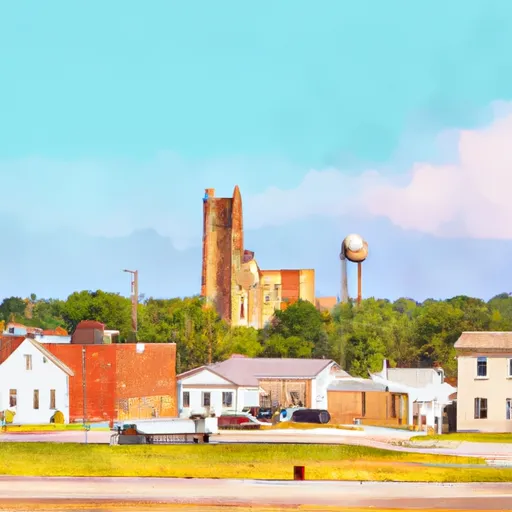-
 Snoflo Premium
Snoflo Premium
Get unlimited access to all our content
With no Ad interruptions! - Start Your Free Trial Login with existing account
Ramona
Eden Index
Climate
8.3
•
Recreation
0.4
•
Community
•
Safeguard
3.4/10

Ramona is a small town located in Marion County, Kansas. It experiences a continental climate with hot summers and cold winters. Summers are typically warm and humid, with average temperatures ranging from the mid-80s to mid-90s Fahrenheit. Winters are generally cold, with temperatures dropping below freezing, and occasional snowfall.
Hydrology in Ramona is predominantly influenced by the nearby Cottonwood River, which flows approximately 3 miles east of the town. The river serves as a valuable water resource and supports a diverse range of fish species, making it popular among anglers.
Despite its small size, Ramona offers several outdoor recreation opportunities. The surrounding area is characterized by picturesque prairie landscapes, making it ideal for activities such as hiking, birdwatching, and nature photography. Additionally, the Cottonwood River provides opportunities for canoeing, kayaking, and fishing, attracting those seeking water-based activities. Ramona is also home to some well-maintained parks and green spaces, providing opportunities for picnicking, sports, and family gatherings. Overall, Ramona offers a tranquil and natural environment for outdoor enthusiasts to explore and enjoy.
What is the Eden Index?
The Snoflo Eden Index serves as a comprehensive rating system for regions, evaluating their desirability through a holistic assessment of climate health, outdoor recreation opportunities, and natural disaster risk, acknowledging the profound impact of these factors on livability and well-being.
Climate Health Indicator (CHI): 8.3
Ramona receives approximately
844mm of rain per year,
with humidity levels near 82%
and air temperatures averaging around
13°C.
Ramona has a plant hardyness factor of
6, meaning
plants and agriculture in this region thrive during a short period during spring and early summer. Most
plants will die off during the colder winter months.
By considering the ideal temperature range, reliable water supplies, clean air, and stable seasonal rain or snowpacks, the Climate Health Indicator (CHI) underscores the significance of a healthy climate as the foundation for quality living.
A healthy climate is paramount for ensuring a high quality of life and livability in a region, fostering both physical well-being and environmental harmony. This can be characterized by ideal temperatures, reliable access to water supplies, clean air, and consistent seasonal rain or snowpacks.
Weather Forecast
Streamflow Conditions
Smoky Hill
Area Rivers
Smoky Hill
Snowpack Depths
Smoky Hill
Reservoir Storage Capacity
Smoky Hill
Groundwater Levels
Recreational Opportunity Index (ROI): 0.4
The Recreational Opportunity Index (ROI) recognizes the value of outdoor recreational options, such as parks, hiking trails, camping sites, and fishing spots, while acknowledging that climate plays a pivotal role in ensuring the comfort and consistency of these experiences.
Access to outdoor recreational opportunities, encompassing activities such as parks, hiking, camping, and fishing, is crucial for overall well-being, and the climate plays a pivotal role in enabling and enhancing these experiences, ensuring that individuals can engage in nature-based activities comfortably and consistently.
Camping Areas
| Campground | Campsites | Reservations | Toilets | Showers | Elevation |
|---|---|---|---|---|---|
| Bear Creek Cove - Kaw Lake | None | 1,049 ft | |||
| Farnum Creek - Milford Lake | 75 | 1,195 ft | |||
| Winfield Fairgrounds RV | None | 1,119 ft | |||
| Napawalla Park | None | 1,158 ft | |||
| Cave Park | None | 1,163 ft | |||
| McConnell AFB Military | None | 1,355 ft | |||
| Walnut River City Park | None | 1,082 ft | |||
| Milford State Park | 250 | 1,213 ft | |||
| Winfield City Lake | None | 1,269 ft | |||
| Newman Park | 8 | 1,067 ft |
Catastrophe Safeguard Index (CSI):
The Catastrophe Safeguard Index (CSI) recognizes that natural disaster risk, encompassing floods, fires, hurricanes, and tornadoes, can drastically affect safety and the overall appeal of an area.
The level of natural disaster risk in a region significantly affects safety and the overall livability, with climate change amplifying these risks by potentially increasing the frequency and intensity of events like floods, fires, hurricanes, and tornadoes, thereby posing substantial challenges to community resilience and well-being.
Community Resilience Indicator (CRI):
The Community Resilience Indicator (CRI) recognizes that education, healthcare, and socioeconomics are crucial to the well-being of a region. The CRI acknowledges the profound impact of these elements on residents' overall quality of life. By evaluating educational resources, healthcare accessibility, and economic inclusivity, the index captures the essential aspects that contribute to a thriving community, fostering resident satisfaction, equity, and social cohesion.

